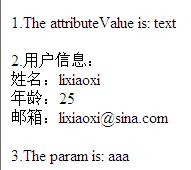原文地址:https://www.cnblogs.com/xiaoxi/p/5718894.html
1、@RequestMapping
@RequestMapping
RequestMapping是一个用来处理请求地址映射的注解(将请求映射到对应的控制器方法中),可用于类或方法上。用于类上,表示类中的所有响应请求的方法都是以该地址作为父路径。
RequestMapping请求路径映射,如果标注在某个controller的类级别上,则表明访问此类路径下的方法都要加上其配置的路径;最常用是标注在方法上,表明哪个具体的方法来接受处理某次请求。
@Controller
@RequestMapping(value="/book")
public class BookController {
@RequestMapping(value="/title")
public String getTitle(){
return "title";
}
@RequestMapping(value="/content")
public String getContent(){
return "content";
}
}
由于BookController类加了value="/book"的@RequestMapping的注解,所以相关路径都要加上"/book",即请求的url分别为:
(1)http://localhost:8080/book/title
(2)http://localhost:8080/book/content
"@RequestMapping"的value值前后是否有“/”对请求的路径没有影响,即value="book" 、"/book"、"/book/"其效果是一样的。
RequestMapping的属性
value:指定请求的实际url
(1)普通的具体值。如前面的value="/book"。
(2)含某变量的一类值。
@RequestMapping(value="/get/{bookId}")
public String getBookById(@PathVariable String bookId,Model model){
model.addAttribute("bookId", bookId);
return "book";
}
路径中的bookId可以当变量,@PathVariable注解即提取路径中的变量值。
(3)ant风格
@RequestMapping(value="/get/id?"):可匹配“/get/id1”或“/get/ida”,但不匹配“/get/id”或“/get/idaa”;
@RequestMapping(value="/get/id*"):可匹配“/get/idabc”或“/get/id”,但不匹配“/get/idabc/abc”;
@RequestMapping(value="/get/id/*"):可匹配“/get/id/abc”,但不匹配“/get/idabc”;
@RequestMapping(value="/get/id/**/{id}"):可匹配“/get/id/abc/abc/123”或“/get/id/123”,也就是Ant风格和URI模板变量风格可混用。
(4)含正则表达式的一类值
@RequestMapping(value="/get/{idPre:\d+}-{idNum:\d+}"):可以匹配“/get/123-1”,但不能匹配“/get/abc-1”,这样可以设计更加严格的规则。
可以通过@PathVariable 注解提取路径中的变量(idPre,idNum)
(5)或关系
@RequestMapping(value={"/get","/fetch"} )即 /get或/fetch都会映射到该方法上。
method:指定请求的method类型, GET、POST、PUT、DELETE等;
@RequestMapping(value="/get/{bookid}",method={RequestMethod.GET,RequestMethod.POST})
params:指定request中必须包含某些参数值是,才让该方法处理。
@RequestMapping(params="action=del"),请求参数包含“action=del”,如:http://localhost:8080/book?action=del
@Controller
@RequestMapping("/owners/{ownerId}")
public class RelativePathUriTemplateController {
@RequestMapping(value = "/pets/{petId}", method = RequestMethod.GET, params="myParam=myValue")
public void findPet(@PathVariable String ownerId, @PathVariable String petId, Model model) {
// implementation omitted
}
}
仅处理请求中包含了名为“myParam”,值为“myValue”的请求。
headers:指定request中必须包含某些指定的header值,才能让该方法处理请求。
@RequestMapping(value="/header/id",
headers = "Accept=application/json"):表示请求的URL必须为“/header/id
且请求头中必须有“Accept =application/json”参数即可匹配。
@Controller
@RequestMapping("/owners/{ownerId}")
public class RelativePathUriTemplateController {
@RequestMapping(value = "/pets", method = RequestMethod.GET, headers="Referer=http://www.ifeng.com/")
public void findPet(@PathVariable String ownerId, @PathVariable String petId, Model model) {
// implementation omitted
}
}
仅处理request的header中包含了指定“Refer”请求头和对应值为“http://www.ifeng.com/”的请求。
consumes:指定处理请求的提交内容类型(Content-Type),例如application/json, text/html。
@Controller
@RequestMapping(value = "/pets", method = RequestMethod.POST, consumes="application/json")
public void addPet(@RequestBody Pet pet, Model model) {
// implementation omitted
}
方法仅处理request Content-Type为“application/json”类型的请求。
produces: 指定返回的内容类型,仅当request请求头中的(Accept)类型中包含该指定类型才返回。
@Controller
@RequestMapping(value = "/pets/{petId}", method = RequestMethod.GET, produces="application/json")
@ResponseBody
public Pet getPet(@PathVariable String petId, Model model) {
// implementation omitted
}
方法仅处理request请求中Accept头中包含了"application/json"的请求,同时暗示了返回的内容类型为application/json;
2、@RequestParam绑定单个请求参数值
@RequestParam用于将请求参数区数据映射到功能处理方法的参数上。
public String requestparam1(@RequestParam String username)
请求中包含username参数(如/requestparam1?username=zhang),则自动传入。
@RequestParam有以下三个参数:
value:参数名字,即入参的请求参数名字,如username表示请求的参数区中的名字为username的参数的值将传入;
required:是否必须,默认是true,表示请求中一定要有相应的参数,否则将抛出异常;
defaultValue:默认值,表示如果请求中没有同名参数时的默认值,设置该参数时,自动将required设为false。
public String requestparam4(@RequestParam(value="username",required=false) String username)
表示请求中可以没有名字为username的参数,如果没有默认为null,此处需要注意如下几点:
原子类型:必须有值,否则抛出异常,如果允许空值请使用包装类代替。
Boolean包装类型:默认Boolean.FALSE,其他引用类型默认为null。
如果请求中有多个同名的应该如何接收呢?如给用户授权时,可能授予多个权限,首先看下如下代码:
public String requestparam7(@RequestParam(value="role") String roleList)
如果请求参数类似于url?role=admin&rule=user,则实际roleList参数入参的数据为“admin,user”,即多个数据之间使用“,”分割;我们应该使用如下方式来接收多个请求参数:
public String requestparam7(@RequestParam(value="role") String[] roleList)
或者
public String requestparam8(@RequestParam(value="list") List<String> list)
3、@PathVariable绑定URI模板变量值
@PathVariable用于将请求URL中的模板变量映射到功能处理方法的参数上。
@RequestMapping(value="/users/{userId}/topics/{topicId}")
public String test(
@PathVariable(value="userId") int userId,
@PathVariable(value="topicId") int topicId)
如请求的URL为“控制器URL/users/123/topics/456”,则自动将URL中模板变量{userId}和{topicId}绑定到通过@PathVariable注解的同名参数上,即入参后userId=123、topicId=456。
4、@ModelAttribute
ModelAttribute可以应用在方法参数上或方法上,他的作用主要是当注解在方法参数上时会将注解的参数对象添加到Model中;当注解在请求处理方法Action上时会将该方法变成一个非请求处理的方法,但其它Action被调用时会首先调用该方法。
4.1 @ModelAttribute注释一个方法
被@ModelAttribute注释的方法表示这个方法的目的是增加一个或多个模型(model)属性。这个方法和被@RequestMapping注释的方法一样也支持@RequestParam参数,但是它不能直接被请求映射。实际上,控制器中的@ModelAttribute方法是在同一控制器中的@RequestMapping方法被调用之前调用的。
被@ModelAttribute注释的方法用于填充model属性,例如,为下拉菜单填充内容,或检索一个command对象(如,Account),用它来表示一个HTML表单中的数据。
一个控制器可以有任意数量的@ModelAttribute方法。所有这些方法都在@RequestMapping方法被调用之前调用。
有两种类型的@ModelAttribute方法。一种是:只加入一个属性,用方法的返回类型隐含表示。另一种是:方法接受一个Model类型的参数,这个model可以加入任意多个model属性。
(1)@ModelAttribute注释void返回值的方法
@Controller
@RequestMapping(value="/test")
public class TestController {
/**
* 1.@ModelAttribute注释void返回值的方法
* @param abc
* @param model
*/
@ModelAttribute
public void populateModel(@RequestParam String abc, Model model) {
model.addAttribute("attributeName", abc);
}
@RequestMapping(value = "/helloWorld")
public String helloWorld() {
return "test/helloWorld";
}
}
这个例子,在获得请求/helloWorld 后,populateModel方法在helloWorld方法之前先被调用,它把请求参数(/helloWorld?abc=text)加入到一个名为 attributeName的model属性中,在它执行后helloWorld被调用,返回视图名helloWorld和model已由 @ModelAttribute方法生产好了。
这个例子中model属性名称和model属性对象由model.addAttribute()实现,不过前提是要在方法中加入一个Model类型的参数。
(2)@ModelAttribute注释返回具体类的方法
/**
* 2.@ModelAttribute注释返回具体类的方法
* @param id
* @return
*/
@ModelAttribute
public User getUserInfo(String id){
if(id!=null && !id.equals("")){
return userService.getUserInfo(id);
}
return null;
}
这种情况,model属性的名称没有指定,它由返回类型隐含表示,如这个方法返回User类型,那么这个model属性的名称是user。
这个例子中model属性名称有返回对象类型隐含表示,model属性对象就是方法的返回值。它无须要特定的参数。
(3)@ModelAttribute(value="")注释返回具体类的方法
@Controller
@RequestMapping(value="/test")
public class TestController {
/**
* 3.@ModelAttribute(value="")注释返回具体类的方法
* @param abc
* @return
*/
@ModelAttribute("str")
public String getParam(@RequestParam String param) {
return param;
}
@RequestMapping(value = "/helloWorld")
public String helloWorld() {
return "test/helloWorld";
}
}
这个例子中使用@ModelAttribute注释的value属性,来指定model属性的名称。model属性对象就是方法的返回值。它无须要特定的参数。
完整的代码:
package demo.controller;
import org.springframework.beans.factory.annotation.Autowired;
import org.springframework.stereotype.Controller;
import org.springframework.ui.Model;
import org.springframework.web.bind.annotation.ModelAttribute;
import org.springframework.web.bind.annotation.RequestMapping;
import org.springframework.web.bind.annotation.RequestParam;
import demo.model.User;
import demo.service.IUserService;
@Controller
@RequestMapping(value="/test")
public class TestController {
@Autowired
private IUserService userService;
/**
* 1.@ModelAttribute注释void返回值的方法
* @param abc
* @param model
*/
@ModelAttribute
public void populateModel(@RequestParam String abc, Model model) {
model.addAttribute("attributeName", abc);
}
/**
* 2.@ModelAttribute注释返回具体类的方法
* @param id
* @return
*/
@ModelAttribute
public User getUserInfo(String id){
if(id!=null && !id.equals("")){
return userService.getUserInfo(id);
}
return null;
}
/**
* 3.@ModelAttribute(value="")注释返回具体类的方法
* @param abc
* @return
*/
@ModelAttribute("str")
public String getParam(@RequestParam String param) {
return param;
}
@RequestMapping(value = "/helloWorld")
public String helloWorld() {
return "test/helloWorld";
}
}
Jsp前台取值:
<%@ page language="java" import="java.util.*" pageEncoding="utf-8"%>
<%
String path = request.getContextPath();
String basePath = request.getScheme()+"://"+request.getServerName()+":"+request.getServerPort()+path+"/";
%>
<!DOCTYPE HTML PUBLIC "-//W3C//DTD HTML 4.01 Transitional//EN">
<html>
<head>
<title>helloWorld</title>
</head>
<body>
1.The attributeValue is: ${attributeName}
<br/><br/>
2.用户信息:<br/>
姓名:${user.user_name}<br/>
年龄:${user.user_age}<br/>
邮箱:${user.user_email}<br/><br/>
3.The param is: ${str}
</body>
</html>
页面效果图:

URL格式:http://localhost/SSMDemo/test/helloWorld?abc=text&id=1¶m=aaa 注:当url或者post中不包含参数abc和参数param时,会报错。
(4)@ModelAttribute和@RequestMapping同时注释一个方法
@Controller
@RequestMapping(value="/test")
public class TestController {
@RequestMapping(value = "/helloWorld")
@ModelAttribute("attributeName")
public String helloWorld() {
return "hi";
}
}
这时这个方法的返回值并不是表示一个视图名称,而是model属性的值, 视图名称由RequestToViewNameTranslator根据请求"/helloWorld"转换为helloWorld。Model属性名称 由@ModelAttribute(value=””)指定,相当于在request中封装了key=attributeName,value=hi。
Jsp页面:
<!DOCTYPE HTML PUBLIC "-//W3C//DTD HTML 4.01 Transitional//EN">
<html>
<head>
<title>helloWorld</title>
</head>
<body>
The attributeValue is: ${attributeName}
</body>
</html>
4.2 @ModelAttribute注释一个方法的参数
@ModelAttribute注释方法的一个参数表示应从模型model中取得。若在model中未找到,那么这个参数将先被实例化后加入到 model中。若在model中找到,则请求参数名称和model属性字段若相匹配就会自动填充。这个机制对于表单提交数据绑定到对象属性上很有效。
当@ModelAttribute注解用于方法参数时,它有 了双重功能,即“存/取”。首先,它从模型中取出数据并赋予对应的参数,如果模型中尚不存在,则实例化一个,并存放于模型中;其次,一旦模型中已存在此数 据对象,接下来一个很重要的步骤便是将请求参数绑定到此对象上(请求参数名映射对象属性名),这是Spring MVC提供的一个非常便利的机制--数据绑定。
@RequestMapping(value = "/login.htm", method = RequestMethod.GET)
public String doLogin(@ModelAttribute("baseMember") BaseMember member) {
member.setLoginName("loginName");
return "home";
}
上述代码中,如果模型中尚不存在键名为“baseMember”的数据,则首先会调用BaseMember类的默认构造器创建一个对象,如果不存在 默认构造器会抛出异常。因此,给实体类提供一个默认构造器是一个好的编程习惯。当请求路径的请求参数或提交的表单与BaseMember的属性名匹配时, 将自动将其值绑定到baseMember对象中,非常的便利!这可能是我们使用@ModelAttribute最主要的原因之一。比如:请求路径为http://localhost:8080/spring-web/login.htm?loginName=myLoginName,baseMember对象中的loginName属性的值将被设置为myLoginName。
4.3 @ModelAttribute注解的使用场景
当@ModelAttribute注解用于方
法时,与其处于同一个处理类的所有请求方法执行前都会执行一次此方法,这可能并不是我们想要的,因此,我们使用更多的是将其应用在请求方法的参数上,而它
的一部分功能与@RequestParam注解是一致的,只不过@RequestParam用于绑定单个参数值,而@ModelAttribute注解可
以绑定所有名称匹配的,此外它自动将绑定后的数据添加到模型中,无形中也给我们提供了便利,这也可能是它命名为ModelAttribute的原因。
5、SessionAttributes
在默认情况下,ModelMap中的属性作用域是request级别,也就是说,当本次请求结束后,ModelMap
中的属性将销毁。如果希望在多个请求中共享ModelMap中的属性,必须将其属性转存到session 中,这样 ModelMap
的属性才可以被跨请求访问。
Spring 允许我们有选择地指定 ModelMap 中的哪些属性需要转存到 session 中,以便下一个请求属对应的 ModelMap 的属性列表中还能访问到这些属性。这一功能是通过类定义处标注 @SessionAttributes 注解来实现的。
package demo.controller;
import org.springframework.stereotype.Controller;
import org.springframework.ui.ModelMap;
import org.springframework.web.bind.annotation.RequestMapping;
import org.springframework.web.bind.annotation.SessionAttributes;
import demo.model.User;
@Controller
@RequestMapping(value="/demo1")
//(1)将ModelMap中属性名为currUser的属性放到Session属性列表中,以便这个属性可以跨请求访问
@SessionAttributes("currUser")
public class Demo1Controller {
@RequestMapping(value="/getUser")
public String getUser(ModelMap model){
User user=new User();
user.setUser_name("zhangsan");
user.setUser_age(25);
user.setUser_email("zhangsan@sina.com");
//(2)向ModelMap中添加一个属性
model.addAttribute("currUser",user);
return "/demo/user";
}
@RequestMapping(value="/getUser1")
public String getUser1(ModelMap model){
User user=(User)model.get("currUser");
System.out.println(user.getUser_name());
System.out.println(user.getUser_age());
System.out.println(user.getUser_email());
return "demo/user1";
}
}
我们在(2)处添加了一个 ModelMap 属性,其属性名为 currUser,而(1)处通过 @SessionAttributes 注解将 ModelMap 中名为 currUser 的属性放置到 Session 中,所以我们不但可以在 getUser() 请求所对应的 JSP 视图页面中通过 request.getAttribute(“currUser”) 和 session.getAttribute(“currUser”) 获取 user 对象,还可以在下一个请求(getUser1())所对应的 JSP 视图页面中通过 session.getAttribute(“currUser”) 或 session.getAttribute(“currUser”)访问到这个属性。
这里我们仅将一个 ModelMap 的属性放入 Session 中,其实 @SessionAttributes 允许指定多个属性。你可以通过字符串数组的方式指定多个属性,如 @SessionAttributes({“attr1”,"attr2”})。此外,@SessionAttributes 还可以通过属性类型指定要 session 化的 ModelMap 属性,如 @SessionAttributes(types = User.class),当然也可以指定多个类,如 @SessionAttributes(types = {User.class,Dept.class}),还可以联合使用属性名和属性类型指定:@SessionAttributes(types = {User.class,Dept.class},value={“attr1”,"attr2”})。
user.jsp页面:
<%@ page language="java" import="java.util.*" pageEncoding="utf-8"%>
<%@ page import="demo.model.User" %>
<%
String path = request.getContextPath();
String basePath = request.getScheme()+"://"+request.getServerName()+":"+request.getServerPort()+path+"/";
%>
<!DOCTYPE HTML PUBLIC "-//W3C//DTD HTML 4.01 Transitional//EN">
<html>
<head>
<base href="<%=basePath%>">
<title>My JSP 'index.jsp' starting page</title>
</head>
<body><br>
<%User user=(User)session.getAttribute("currUser");%>
用户名:<%=user.getUser_name() %><br/>
年龄:<%=user.getUser_age() %><br/>
邮箱:<%=user.getUser_email() %><br/><br/>
<a href="<%=path %>/demo1/getUser1">跳转</a>
</body>
</html>
通过@ModelAttribute绑定
@SessionAttributes 是用来在 controller 内部共享 model 属性的。我 们可以在需要访问 Session 属性的 controller 上加上 @SessionAttributes,然后在 action 需要的 User 参数上加上 @ModelAttribute,并保证两者的属性名称一致。SpringMVC 就会自动将 @SessionAttributes 定义的属性注入到 ModelMap 对象,在 setup action 的参数列表时,去 ModelMap 中取到这样的对象,再添加到参数列表。只要我们不去调用 SessionStatus 的 setComplete() 方法,这个对象就会一直保留在 Session 中,从而实现 Session 信息的共享。
@Controller
@SessionAttributes("currentUser")
public class GreetingController{
@RequestMapping
public void hello(@ModelAttribute("currentUser") User user){
//user.sayHello()
}
}
@SessionAttributes清除
@SessionAttributes需要清除时,使用
SessionStatus.setComplete();来清除。注意,它只清除@SessionAttributes的session,不会清除
HttpSession的数据。故如用户身份验证对象的session一般不用它来实现,还是用session.setAttribute等传统的方式实
现。
6、@Responsebody与@RequestBody
@Responsebody表示该方法的返回结果直接写入HTTP response
body中。一般在异步获取数据时使用,在使用@RequestMapping后,返回值通常解析为跳转路径,加上@Responsebody后返回结果
不会被解析为跳转路径,而是直接写入HTTP response
body中。比如异步获取json数据,加上@Responsebody后,会直接返回json数据。
@RequestBody将HTTP请求正文插入方法中,使用适合的HttpMessageConverter将请求体写入某个对象。
$("#btn2").click(function(){
var url='<%=request.getContextPath()%>/User/addUserInfo';
var data={"user_name":$("#userName").val(),"user_sex":$("#userSex").val(),"user_age":$("#userAge").val(),
"user_email":$("#userEmail").val(),"user_telephone":$("#userTelephone").val(),"user_education":$("#userEducation").val(),
"user_title":$("#userTitle").val()};
$.ajax({
type:'POST',
contentType : 'application/json',
url:url,
dataType:"json",
data:JSON.stringify(data),
async:false,
success:function(data){
alert("新增成功!");
},
error: function(XMLHttpRequest, textStatus, errorThrown){
alert(XMLHttpRequest.status);
alert(XMLHttpRequest.readyState);
alert(textStatus);
}
})
})
@RequestMapping(value="/addUserInfo",method=RequestMethod.POST)
@ResponseBody
//将请求中的data写入UserModel对象中
public String addUserInfo(@RequestBody UserModel user){
System.out.println("user_name--------"+user.getUser_name());
System.out.println("user_sex--------"+user.getUser_sex());
System.out.println("user_age--------"+user.getUser_age());
System.out.println("user_email--------"+user.getUser_email());
System.out.println("user_title--------"+user.getUser_title());
System.out.println("user_education--------"+user.getUser_education());
System.out.println("user_telephone--------"+user.getUser_telephone());
//不会被解析为跳转路径,而是直接写入HTTP response body中
return "{}";
}
@RequestBody 将HTTP请求正文转换为适合的HttpMessageConverter对象。
@ResponseBody 将内容或对象作为 HTTP 响应正文返回,并调用适合HttpMessageConverter的Adapter转换对象,写入输出流。
@RequestBody
作用:
i) 该注解用于读取Request请求的body部分数据,使用系统默认配置的HttpMessageConverter进行解析,然后把相应的数据绑定到要返回的对象上;
ii) 再把HttpMessageConverter返回的对象数据绑定到 controller中方法的参数上。
使用时机:
A) GET、POST方式提时, 根据request header Content-Type的值来判断:
application/x-www-form-urlencoded, 可选(即非必须,因为这种情况的数据@RequestParam, @ModelAttribute也可以处理,当然@RequestBody也能处理);
multipart/form-data, 不能处理(即使用@RequestBody不能处理这种格式的数据);
其他格式, 必须(其他格式包括application/json, application/xml等。这些格式的数据,必须使用@RequestBody来处理);
B) PUT方式提交时, 根据request header Content-Type的值来判断:
application/x-www-form-urlencoded, 必须;
multipart/form-data, 不能处理;
其他格式, 必须;
说明:request的body部分的数据编码格式由header部分的Content-Type指定;
@ResponseBody
作用:
该注解用于将Controller的方法返回的对象,通过适当的HttpMessageConverter转换为指定格式后,写入到Response对象的body数据区。
使用时机:
返回的数据不是html标签的页面,而是其他某种格式的数据时(如json、xml等)使用;
